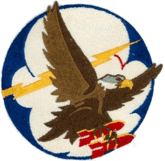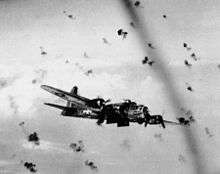731st Bombardment Squadron
The 731st Bombardment Squadron is an inactive United States Air Force unit. It was last active during the Korean War, assigned to the 452d Bombardment Group but attached to the 3d Bombardment Group at Iwakuni Air Base, Japan, where it was inactivated on 25 June 1951.
| 731st Bombardment Squadron | |
|---|---|
_in_Korea.jpg) B-26 Invader camouflaged for night operations in Korea | |
| Active | 1943–1945; 1947–1951 |
| Country | |
| Branch | |
| Role | Bombardment |
| Part of | Far East Air Forces |
| Engagements | European Theater of Operations Korean War |
| Decorations | Distinguished Unit Citation Republic of Korea Presidential Unit Citation |
| Insignia | |
| 731st Bombardment Squadron emblem (approved 26 October 1943)[1] |  |
The squadron was first activated in 1943. After training in the United States with the Boeing B-17 Flying Fortress, the squadron deployed to the European Theater of Operations, participating in the strategic bombing campaign against Germany. It earned a Distinguished Unit Citation (DUC) during an attack on a German jet fighter base near Kaltenkirchen in April 1945. Following V-E Day, the squadron returned to the United States and was inactivated.
The squadron was activated again in the reserves in 1947. Two years later, it began to train with Douglas B-26 Invaders. In August 1950, the squadron was one of the first reserve units mobilized for the Korean War. After filling its ranks and undergoing intensive training, the squadron deployed to Far East Air Forces and began flying combat missions. It was awarded two additional DUCs for its operations in Korea. In June 1951, the squadron was inactivated and its personnel and equipment were transferred to a regular unit that was simultaneously activated.
History
World War II

The squadron was first activated in June 1943 at Geiger Field, Washington as one of the four original squadrons of the 452d Bombardment Group. Later that month, it moved to Rapid City Army Air Base, South Dakota and began to train with the Boeing B-17 Flying Fortress. It continued training with Second Air Force until December, when it began its movement to the European Theater of Operations.[1][2] The ground echelon staged through Camp Shanks and sailed on the RMS Queen Elizabeth on 2 January 1944. The air echelon deployed via the South Atlantic air ferry route[3]
The squadron established itself at RAF Deopham Green in January 1944, and began operations on 4 February 1944 with a strike on an aircraft assembly plant near Brunswick. Its strategic targets included railroad marshalling yards near Frankfurt, aircraft factories near Regensberg and Kassel. the ball bearing factory at Schweinfurt and an oil refinery near Bohlen.[2] In September 1944, the squadron participated in the third shuttle mission, striking Chemnitz before landing in bases in the Soviet Union.[4]
The 731st was occasionally diverted to support tactical operations. It hit airfields, V-weapon launching sites, bridges and other objectives in preparations for Operation Overlord, the invasion of Normandy. It bombed enemy positions to support Operation Cobra, the breakout at Saint Lo in July 1944 and the attacks on Brest, France in August. It supported Operation Market Garden, airborne attacks in the Netherlands in September and, during the Battle of the Bulge, struck German lines of communication. It struck an airfield to support Operation Varsity, the airborne assault across the Rhine.[2]
Shortly before the end of the war, on 7 April, the squadron struck the jet fighter base at Kaltenkirchen, pressing the attack despite strong fighter opposition, earning a Distinguished Unit Citation. It flew its last mission of the war on 21 April against marshalling yards at Ingolstadt.[2]
After V-E Day, in August 1945, the squadron returned to the United States (the ground echelon once again sailed on the RMS Queen Elizabeth)[3] and was inactivated at Sioux Falls Army Air Field, South Dakota.[1]
Reserve duty and Korean War call-up
The squadron was reactivated in the reserve at Long Beach Army Air Field, California in 1947 as a very heavy bomber squadron, but conducted proficiency flying with a variety of trainer airplanes under the supervision of the 416th AAF Base Unit (later the 2347th Air Force Reserve Training Center).[5][6] In a 1949 reorganization of the reserves, it became a light bomber squadron and began to equip and train with Douglas B-26 Invaders. The squadron was manned at only 25% of its authorized strength.[7]
The squadron was mobilized for the Korean War in August 1950 in the first wave of reserve mobilizations. To help bring it up to strength, the squadron was augmented by reservists assigned to the 448th Bombardment Wing, which was also stationed at Long Beach, but remained in reserve status until the following year.[8] The 731st was a squadron of one of the first two reserve wings to be mobilized,[note 1] and administrative provisions for mobilization proved inadequate, with numerous reservists never received the telegrams calling them to active duty.[9]
The unit moved to George Air Force Base, California for intensive training and to be brought up to full strength. In October, the squadron deployed to Iwakuni Air Base, Japan to begin combat operations.[1] The Air Force decided that, unlike the three other squadrons of the 452d Group, the 731st would be trained for night intruder operations. Although the squadron remained part of the 452d until inactivated, it was attached to the understrength 3d Bombardment Group upon its arrival in theater.[1][10] Four of its crews left George in mid-September and participated in combat operations with the 3d Group during October, although the first mission by the squadron was on 24 November. The 731st flew night bombing missions at all altitudes, using both visual and radar techniques. Its invaders also flew close air support and armed reconnaissance flights. It also flew flare drop missions, operating Douglas C-47 Skytrains. By June 1951, the 731st had flown more than 9,000 hours of combat and 2,000 combat sorties.[11]
The remaining two squadrons assigned to the 3d Bombardment Group had also been put on night operations. In June 1951, the 3d was brought up to strength by the activation of the 90th Bombardment Squadron, and the squadron was inactivated while its personnel and aircraft transferred to the 90th and other elements of the 3d Group.[1][11]
Lineage
- Constituted as the 731st Bombardment Squadron (Heavy) on 14 May 1943
- Activated on 1 June 1943
- Redesignated 731st Bombardment Squadron, Heavy on 20 August 1943
- Inactivated on 28 August 1945
- Redesignated 731st Bombardment Squadron, Very Heavy on 13 May 1947
- Activated in the reserve on 12 July 1947
- Redesignated 731st Bombardment Squadron, Light on 27 June 1949
- Redesignated 731st Bombardment Squadron, Light, Night Attack on 1 August 1950
- Ordered to active service on 10 August 1950
- Inactivated on 25 June 1951[1]
Assignments
- 452d Bombardment Group, 1 June 1943 – 28 August 1945
- 452d Bombardment Group, 12 July 1947 – 25 June 1951 (attached to 3d Bombardment Group after November 1950)[1]
Stations
- Geiger Field, Washington, 1 June 1943
- Rapid City Army Air Base, South Dakota, c. 13 June 1943
- Pendleton Field, Oregon, 10 October 1943
- Walla Walla Army Air Base, Washington, c. 4 November–December 1943
- RAF Deopham Green (AAF-142),[12] England, c. 8 January 1944 – 6 August 1945
- Sioux Falls Army Air Field, South Dakota, c. 12–28 August 1945
- Long Beach Army Air Field (later Long Beach Municipal Airport), California, 19 April 1947
- George Air Force Base, California, 10 August–October 1950
- Iwakuni Air Base, Japan, 17 November 1950 – 25 June 1951[1]
Aircraft
Awards and campaigns
| Award streamer | Award | Dates | Notes |
|---|---|---|---|
| Distinguished Unit Citation | Germany, 7 April 1945 | [1] | |
| Distinguished Unit Citation | Korea, 22 April 1951 – 25 June 1951 | [1] | |
| Republic of Korea Presidential Unit Citation | Korea, 27 Oct 1950 – 25 June 1951 | [1] |
| Campaign Streamer | Campaign | Dates | Notes |
|---|---|---|---|
| Air Offensive, Europe | 8 January 1944 – 5 June 1944 | [1] | |
| Normandy | 6 June 1944 – 24 July 1944 | [1] | |
| Northern France | 25 July 1944 – 14 September 1944 | [1] | |
| Rhineland | 15 September 1944 – 21 March 1945 | [1] | |
| Ardennes-Alsace | 16 December 1944 – 25 January 1945 | [1] | |
| Central Europe | 22 March 1944 – 21 May 1945 | [1] | |
| Air Combat, EAME Theater | 7 December 1941 – 11 May 1945 | [1] | |
| CCF Intervention | 24 November 1950 – 24 January 1951 | [1] | |
| 1st UN Counteroffensive | 25 January 1951 – 21 April 1951 | [1] | |
| CCF Spring Offensive | 22 April 1951 – 25 June 1951 | [1] |
See also
- B-17 Flying Fortress units of the United States Army Air Forces
- List of A-26 Invader operators
- List of Douglas C-47 Skytrain operators
References
- Notes
- The other was the 437th Troop Carrier Wing.
- Although Maurer does not list any operational aircraft assigned to the squadron for the period 1947–1949, Air Force Historical Research Agency Factsheets for the 452d Group and its other three squadrons indicated they operated North American T-6 Texans and two-engine Beechcraft trainers during this period.
- Citations
- Maurer, Combat Squadrons, p. 726
- Maurer, Combat Units, pp. 326–328
- Freeman, p. 258
- Freeman, p. 188
- "Abstract, History 416 AAF Base Unit Jan–Mar 1945". Air Force History Index. Retrieved 7 May 2017.
- "Abstract, History 2347 Air Force Reserve Training Center Jul–Sep 1950". Air Force History Index. Retrieved 7 May 2017.
- Cantwell, p. 74
- Cantwell, p. 92, Maurer, Combat Units, pp. 522–523
- Cantwell, p. 93
- Cantwell, p. 92
- Cantwell, p. 103
- Station number in Anderson.
Bibliography
![]()
- Anderson, Capt. Barry (1985). Army Air Forces Stations: A Guide to the Stations Where U.S. Army Air Forces Personnel Served in the United Kingdom During World War II (PDF). Maxwell AFB, AL: Research Division, USAF Historical Research Center. Archived from the original (PDF) on 23 January 2016.
- Cantwell, Gerald T. (1997). Citizen Airmen: a History of the Air Force Reserve, 1946–1994. Washington, D.C.: Air Force History and Museums Program. ISBN 0-16049-269-6.
- Freeman, Roger A. (1970). The Mighty Eighth: Units, Men and Machines (A History of the US 8th Army Air Force). London, England, UK: Macdonald and Company. ISBN 978-0-87938-638-2.
- Maurer, Maurer, ed. (1983) [1961]. Air Force Combat Units of World War II (PDF) (reprint ed.). Washington, DC: Office of Air Force History. ISBN 0-912799-02-1. LCCN 61060979.
- Maurer, Maurer, ed. (1982) [1969]. Combat Squadrons of the Air Force, World War II (PDF) (reprint ed.). Washington, DC: Office of Air Force History. ISBN 0-405-12194-6. LCCN 70605402. OCLC 72556.
- Further reading
- Endicott, Judy G., ed. (2001). The USAF in Korea, Campaigns, Units and Stations 1950-1953 (PDF). Maxwell AFB, AL: Air Force Historical Research Agency. ISBN 0-16-050901-7.
- Ravenstein, Charles A. (1984). Air Force Combat Wings, Lineage & Honors Histories 1947-1977. Washington, DC: Office of Air Force History. ISBN 0-912799-12-9.



